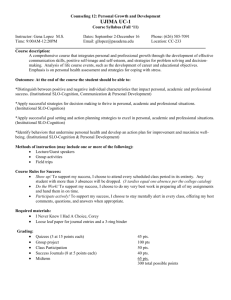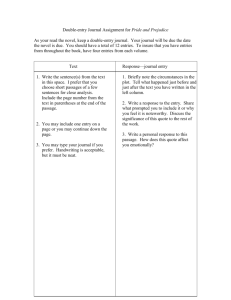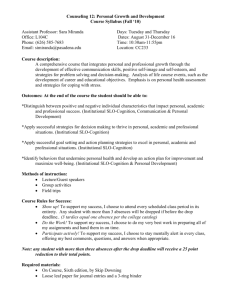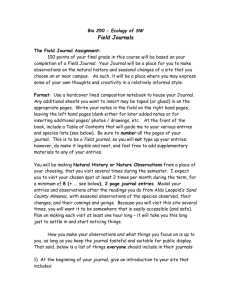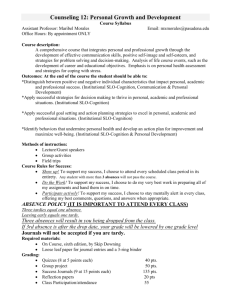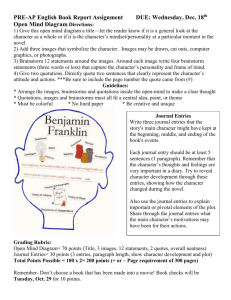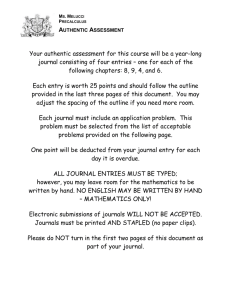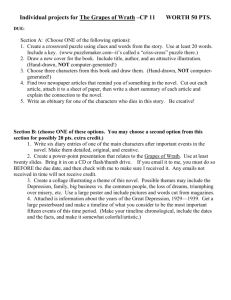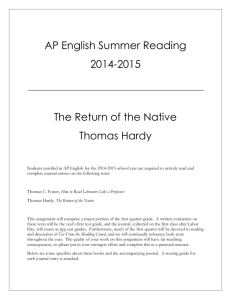1 June 2013 Dear Student: Welcome to AP English Language and
advertisement
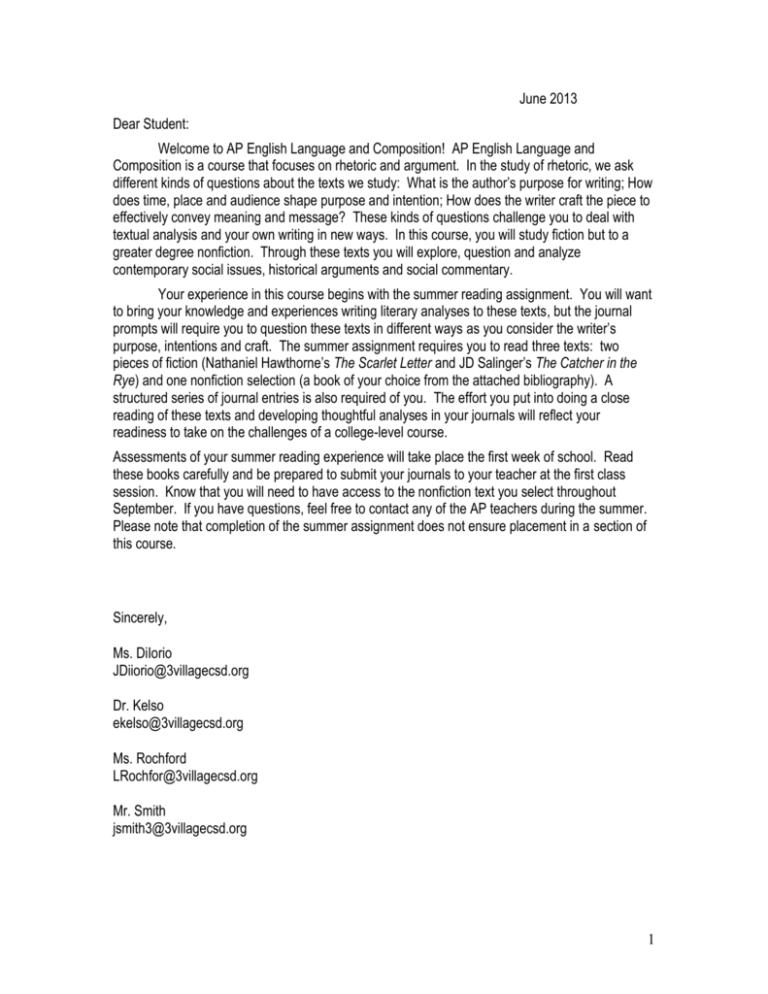
June 2013 Dear Student: Welcome to AP English Language and Composition! AP English Language and Composition is a course that focuses on rhetoric and argument. In the study of rhetoric, we ask different kinds of questions about the texts we study: What is the author’s purpose for writing; How does time, place and audience shape purpose and intention; How does the writer craft the piece to effectively convey meaning and message? These kinds of questions challenge you to deal with textual analysis and your own writing in new ways. In this course, you will study fiction but to a greater degree nonfiction. Through these texts you will explore, question and analyze contemporary social issues, historical arguments and social commentary. Your experience in this course begins with the summer reading assignment. You will want to bring your knowledge and experiences writing literary analyses to these texts, but the journal prompts will require you to question these texts in different ways as you consider the writer’s purpose, intentions and craft. The summer assignment requires you to read three texts: two pieces of fiction (Nathaniel Hawthorne’s The Scarlet Letter and JD Salinger’s The Catcher in the Rye) and one nonfiction selection (a book of your choice from the attached bibliography). A structured series of journal entries is also required of you. The effort you put into doing a close reading of these texts and developing thoughtful analyses in your journals will reflect your readiness to take on the challenges of a college-level course. Assessments of your summer reading experience will take place the first week of school. Read these books carefully and be prepared to submit your journals to your teacher at the first class session. Know that you will need to have access to the nonfiction text you select throughout September. If you have questions, feel free to contact any of the AP teachers during the summer. Please note that completion of the summer assignment does not ensure placement in a section of this course. Sincerely, Ms. DiIorio JDiiorio@3villagecsd.org Dr. Kelso ekelso@3villagecsd.org Ms. Rochford LRochfor@3villagecsd.org Mr. Smith jsmith3@3villagecsd.org 1 AP English Language and Composition Summer Reading Assignment - 2013-2014 Assignment Required for all AP English Language and Composition Students Assignment: For the summer assignment, you will need to read three books and develop journal entries on those texts. There are four journal entries where you respond to The Scarlet Letter by Nathaniel Hawthorne; two entries on JD Salinger’s The Catcher in the Rye and one extended entry on a nonfiction book of your choice. Some of these journals will require you to research topics related to the text to enhance your understanding of the story. Writing should not be a summary of chapters of the novel, rather a discussion using thoughtful analysis, specific references to the text and outside research that deepens your understanding of each book’s context and each author’s time and place. Evaluation: 1 2 3 Journal entries are due the first day of class. See below for specific guidelines for each entry. We will use your writing the first few weeks of school. Students will sit for an essay exam based on the two works of fiction. A second assessment will examine the nonfiction selection. Procedure for Journal: 1 Each journal entry should be 2-handwritten, loose-leaf pages (wide ruled). Typed journals will not be accepted! Each entry should have a proper heading (see the example below) and should be neatly stapled together when the assignment is due. 2 All work completed in your journal should be expressly your own. Journals should not be copied or completed with others. Feel free to discuss your books with others; writing should be completed individually. Information copied from Sparknotes, other online sources or students’ journals will be considered plagiarized and will earn a grade of zero. 3 Write in blue or black ink. NO PENCIL (it smudges and is hard to read). The journal entries are TOOLS, so they will not be a “final draft” or perfectly neat artifacts; they must, however, be readable. Feel free to cross through, scratch out, or insert. Editing marks are perfectly acceptable. 4 Read through specific assignments before beginning the book. The journal assignment will shape how you read and respond. All writing should be a rich balance between your analysis, textual support, and outside research. All ideas not your own should be cited using parenthetical citations. 5 Complete journals as you read. Since each assignment requires a close reading of the text, information you collect cannot be found in movies, plot summaries, or online sites such as Sparknotes. Make sure you incorporate direct quotes and/or cite sources to support your ideas. Textual references should be brief and relevant and should be followed by page or paragraph numbers. 6 If you own the book, practice marking in the book as you read, noting and highlighting, underlining striking words, key details, events and all of the information you find that will help you develop your journal entry. A full digital copy of Hawthorne’s The Scarlet Letter can be found online at http://www.bartleby.com/83/. You may find it worthwhile to print reading assignments, staple these small sections and carry them with you where you go. A quiet spot on the beach, in your backyard, or in your house may offer comfortable ways to read and think about this story. On a hardcopy, you can write all over the page, annotating as you go. This process also breaks your novel into achievable chunks that you may find manageable. 7 On the top line of each page, write the TOPIC, DATE, AND ENTRY NUMBER. (Below is a model of this heading.) Research and Allusion July 1, 2012 Entry 1 2 Entries 1-7 Entry # Element of Study 1. Research and Allusion Instructions The Scarlet Letter The Puritan society was a theocracy, a government where law and religion were enmeshed. Hawthorne’s story furthers this connection through his use of allusions and diction that fall within the religious sphere. Ideas such as redemption, repentance, confession, revelation, martyr, infernal pit, sin, “her fall”, Eden, the devil, and original sin are a few you will encounter. Familiarize yourself with the meanings of these words. Research phrases such as original sin and “The Fall” of the “Garden of Eden”. How did Puritan religious beliefs shape their society? Take notes and make observations in your journal. Identify and gather Hawthorne’s allusions to the Fall of Man and original sin as you read. How does Hawthorne use the notion of original sin in this novel? How does this idea shape the community’s perception of Hester, Pearl, Arthur and Roger? How does it affect the way you read the novel? Use specific references with page numbers. Provide authors, titles or URLs for outside research. [2 page entry] 2. Ethics 3. Juxtaposition 4. Research for Historical Context The idea of a moral code is that such belief systems or philosophies in life helps individuals make determinations between good/bad and right/wrong. The Puritans had a religious basis to their code. But despite a very present code, we see people making quite a few errors in judgment. Hester follows her passion and has a child out of wedlock, and she’s supposed to be married to someone else! Certainly a moral error that didn’t go unnoticed. Identify a few aspects of the story that suggests the compromise of moral viewpoints. What do you notice? Why is it problematic? What does this reveal about the complexity of human nature? Use specific references with page numbers. [2 page entry] Explain what Hawthorne gains from juxtaposing ideas: love and hate, acceptance and rejection, darkness and light, sunshine and shadow, pride and humility, sin and redemption, public and private, emotion and reason? Explore some of these juxtapositions. Use specific references with page numbers. [2 page entry] Nathaniel Hawthorne published his novel in 1850, but this story is described as a “romance of seventeenthcentury Boston.” As you read this novel, you may begin to ask questions like “What was the relationship between the Puritans and Native Americans?”; “What was the likelihood of surviving cross-Atlantic travel in the 1600s?”; “What characterized medicine, government, or rules for daily living in the Puritan colony?”; or “What is the difference between the Puritans and Pilgrims?” This entry challenges you to research questions that arise for you from the novel. How does this research help you to better understand the novel? How does this novel build on or connect to what you have studied about Puritan life in other classes or your summer AP history assignment? What does Hawthorne want us to know? Make explicit connections between the novel and your research. Use specific references with page numbers. Provide authors, titles or URLs for outside research. [2 page entry] 5. Diction and Meaning 6. Research and Context The Catcher in the Rye Make a list of word and phrases Holden uses frequently. How do these words construct Holden’s attitude toward other people and society? Also notice words Holden uses when talking about his brother Allie or sister Phoebe. What do these words suggest about his attitude toward them? Use specific references with page numbers. [2 page entry] Salinger’s novel is viewed as a post-war commentary. Research American youth post World War II. What issues were pressing at the time? How do these help us to understand Holden and his world? What did Salinger want us to know? Use specific references with page numbers. Provide authors, titles or URLs for outside research. [2 page entry] 7. A Concept: Argument Independent Reading Selection As you read your book, identify the writer’s argument (primary and secondary claims). You find these by asking yourself some questions: What is the main argument the writer makes? What does the author want me to know? How is the author proving that point to me? What evidence is being used to develop the ideas in the book? Does the author present interviews or testimony? Does the author present facts and statistics? Where does that information come from originally? Does the author cite sources? Is other research referred to? Are stories, analogies or anecdotes told to further the ideas? Note: Arguments are made throughout a text. This entry should be developed piece-by-piece as you continue to read your book. It should be an ongoing process entry. This entry should be six pages and it should draw on ideas presented throughout the book. Use specific references with page numbers. [4-6 page entry] 3 Nonfiction Reading Assignment - Bibliography Baldwin, James. Notes of a Native Son Berry, Wendell. What Are People For? Bikerts, Sven. The Gutenberg Elegies Caputo, Philip. A Rumor of War Darwin, Charles. The Descent of Man: On the Origin of the Species Darwin, Charles. The Voyage of the Beagle Dawkins, Richard. The Devil’s Chaplain Delman, Carmit. Burnt Bread and Chutney: Growing Up Between Cultures—A Memoir of an Indian Jewish Girl. Didion, Joan. Slouching Toward Bethlehem; or The White Album Dillard, Annie. An American Childhood or Pilgrim at Tinker Creek Ehrenreich, Barbara. Nickel and Dimed Ehrlich, Gretel. The Solace of Open Spaces Eiseley, Loren. The Immense Journey; or The Night Country Fortey, Richard. Trilobite! Frazier, Ian. The Great Plains; or On the Rez Friedman, Thomas. Hot, Flat, and Crowded: Why We Need a Green Revolution--and How It Can Renew America; or The World Is Flat 3.0: A Brief History of the Twentyfirst Century Gabler, Neil. Life the Movie Gould, Stephen Jay. The Flamingo’s Smile; or The Mismeasure of Man Greene, Melissa Faye. Praying for Sheetrock Hedges, Chris. War is a Force That Gives Us Meaning Horwitz, Tony. Confederates in the Attic Hurston, Zora Neale. Dust Tracks on a Road Huxley, TH. Evolution and Ethics, and Other Essays Isaacson, Walter. Steve Jobs; or Benjamin Franklin: An American Life; or Einstein: His Life and Universe Kaplan, Robert. The Nothing That Is: A Natural History of Zero Krakauer, Jon. Into Thin Air King, Stephen. On Writing Kingston, Maxine Hong. The Woman Warrior: Memoirs of Girlhood Among Ghosts Levi, Primo. The Period Table of Elements; or Survival in Auschwitz Lopez, Barry. Arctic Dreams; or Crossing Open Ground Markham, Beryl. West with the Night Matthieson, Peter. The Snow Leopard McBride, James. The Color of Water: A Black Man’s Tribute to His White Mother McDougall, Christopher. Born to Run McPhee, John. The Control of Nature; or Table of Contents Mencken, HL. The American Language; or In Defense of Women Moore, Wes. The Other Wes Moore: One Name, Two Fates Nathan, Rebekah. My Freshman Year: What a Professor Learned by Becoming a Student Nguyen, Kien. The Unwanted: A Memoir of Childhood O’Casey, Sean. I Knock at the Door O’Connor, Frank. An Only Child 4 Obama, Barack. The Audacity of Hope: Thoughts on Reclaiming the American Dream Orwell, George. The Road to Wigan Pier; or Down and Out in Paris and London Pham, Andrew X. Catfish and Mandala Pollan, Michael. The Botany of Desire; or The Omnivore’s Dilemma Postman, Neil. Amusing Ourselves to Death; or Technopoly Salzman, Mark. Iron & Silk. Schama, Simon. Dead Certainties: Unwarranted Speculations Shabazz, Attallah, Haley, Alex and Malcolm X. The Autobiography of Malcolm X: As Told to Alex Haley Shipler, David K. The Working Poor: Invisible in America Sontag, Susan. On Photography; or Regarding the Pain of Others Thomas, Lewis. The Lives of a Cell Tuchman, Barbara. The Guns of August; or The March to Folly Verghese, Abraham. My Own Country Vowell, Sarah. The Wordy Shipmates Walker Alice. In Search of our Mother's Gardens Wearing, Alison. Honeymoon in Purdah Weiner, Jonathan. The Beak of the Finch; or Time, Love, Memory Welty, Eudora. One Writer’s Beginnings; or The Eye of the Story White, EB. One Man’s Meat White, Ronald, Jr. Lincoln’s Greatest Speech: The Second Inauguration Wiesel, Elie. All Rivers Run to the Sea; or And the Sea Is Never Full Wills, Gary. Lincoln at Gettysburg: The Words That Remade America Wolff, Tobias. This Boy’s Life Woolf, Virginia. Three Guineas Wright, Richard. Black Boy 5 Summer Assignment - Journal Rubric 2012 Excellent Student’s Name Good Needs Improvement Points Organization: Complete headings 0-10 10 8 6 0-10 Neatness and Care 10 8 6 Completion: 7 Entries (1-6) are 2 single-page entries. Entry 7 is 4-6 single-page entries. All 7 entries submitted and meet the appropriate page length. (18-20 pts.) Most entries meet the required page length. (14-17 pts.) Multiple entries missing and/or entries do not meet the required page length. (10-13 pts.) 0-20 Thoughtful Analysis to the Text: student uses quotes and specific references to the text and includes page numbers. Thoroughly developed response. Some evidence of developed ideas. Too much plot summary. Little or no analysis. 0-30 Thoughtful analysis of the text. Explicitly refers to the text. (28-30 pts.) Some interesting interpretations of the text. Brief references to the text. (25-27 pts.) Needs development & elaboration (20-24 pts.) Outside Research: students connected the text to outside sources and researched stated topics when needed. Excellent evidence of outside research and connections. Refers to those sources explicitly. (28-30 pts.) Some evidence of outside research and connections with some source information. (25-27 pts.) Little evidence of outside research or source information. (20-24 pts.) 0-30 Final Grade See me 6
